
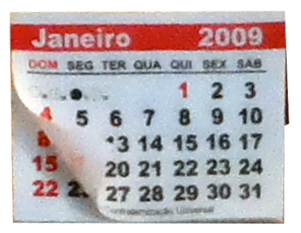

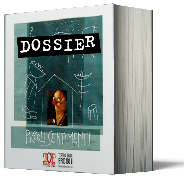

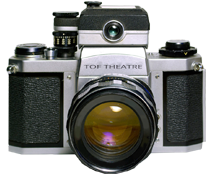

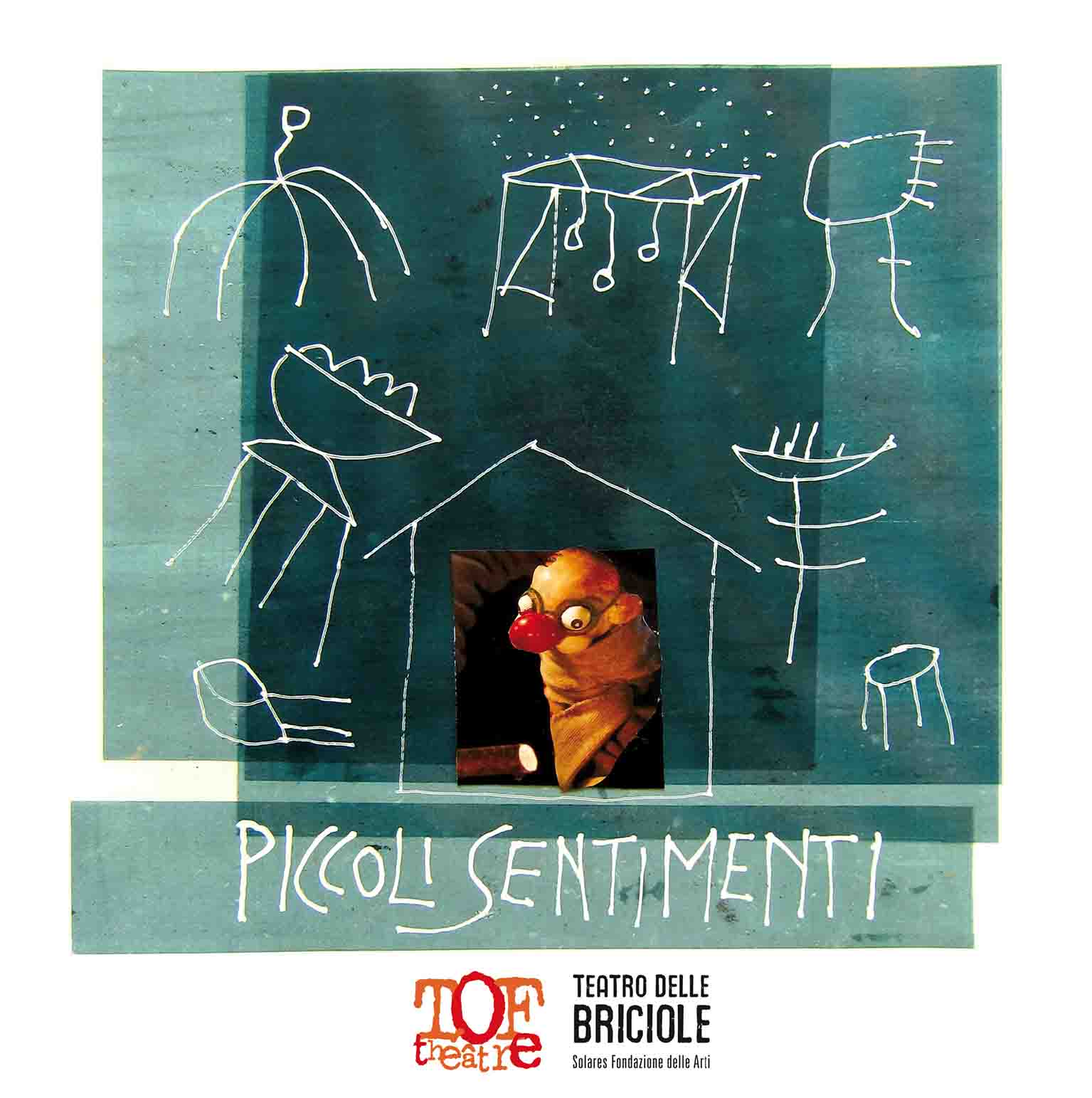 A
show without words for an audience of age 3 and up, drawing its
inspiration from the world of Antonio Catalano.
A
show without words for an audience of age 3 and up, drawing its
inspiration from the world of Antonio Catalano.
The audience sits on the very edge of the stage within a cocoon of
veils, as close to the action as possible. In front of them is a set
with earth, a moon-loaf of bread, a sky of bamboo and a number of
little wooden constructions made of tiny twigs and sticks. A light
breeze flutters the leaves. It is the beginning of the world. Then,
all of a sudden, something stirs under the earth: a creature, an
indefinable thing, crawling on all fours. When its face appears the
performance of «Little Emotions» truly begins and this unique
character, no bigger than a hand, starts to experience feelings, one
by one. Fear, desire, solitude, joy, anger, wonderment - the whole
spectrum is explored but without a word, just hearing, sight and touch
(after all, there is more than one sense that captures feelings!)In an
exquisite blending of the Tof Theatre’s unhinged and sensitive world
of puppetry, the ‘art brut’ of Antonio Catalano and the ‘untamed
lutherie’ of patamusician Max Vandervorst, Piccoli Sentimenti concocts
a hymn to the marvel of the marvelous awakening to artistic
sensibility!
A show dreamed up by Antonio Catalano and
Alain Moreau
Script, puppetry and staging: Alain Moreau
Artistic accompaniment : Antonio Catalano
Scenography: Alain Moreau, along the lines of an original idea
instigated by Antonio Catalano
Creation of the soundscape, musical instruments and musical score: Max
Vandervorst
Creative team: Sandrine Hooge, Céline Robaszynski
Creation of lighting: Emiliano Curà and Dimitri Joukovsky
Performance: Céline Robaszynski and Lisou De Henau
Touring stage manager: Bao Khanh Ngouansavanh or Jérôme Lenain
Assistant to the scenography : Céline Robaszynski
Costumes : Patrizia Caggiati
Construction du plateau et bidouillages divers : Paolo Romanini
Setting in orbit and inspired advice: My-Linh Bui
Precious help with direction : Sarah Demarthe
Production : Tof Théâtre and Teatro delle Briciole
Co-production : Festival A pas contés (Dijon), Le Granit - Scène
Nationale de Belfort, L’Arche - Scène Nationale du Pays de
Montbéliard, L’Yonne en Scène.
Distribution : My-Linh Bui - Kurieuze & Cies

The Genesis of the project...
“Unlimited Freedom”. These were the words
Flavia Armenzoni used when she confided
me with the creation of a
show
at Teatro delle Briciole...
Naturally, I was thrilled.
We soon
envisioned a co-production. After all, the two companies have worked
closely for years and the timing was perfect. When I returned from
Parma, where
we had begun discussing the project,
I took a few days
to visit Antonio Catalano in his bucolic hideaway in the hills at the
Casa degli Alfieriof near the Asti region of Italy. As always, we were
very happy to see each other again.
In his workshop, I discovered one
of
this prolific artist’s many projects in construction. The floor
was scattered with miniature constructions and strange towers made of
hazel wood...
It was very beautiful. Antonio explained that it was actually the
model for what he envisioned as a monumental outdoor project. I’ve
always loved miniatures and it immediately tempted me...
. I felt a
strong urge to explore his strange little world and to merge it with
my own. Later on, without him knowing, I went back to his workshop
accompanied by a little puppet. I often carry this puppet around with
me as it helps me experiment with things in my free time and I’ve
always thought I might do a show with it....
After a few minutes of
exploring Antonio’s sensitive world, I sensed something very
interesting happening, something altogether possible! After
improvising with my puppet in front of him, Antonio immediately set
about building other miniature constructions. And then, very
naturally, a sort of Ping-Pong of ideas began - the adventure had
begun! A very simple show emerged about curiosity and the discovery of
this poetic and strange universe. There was light playing, a changing
wind, minimalist music, sounds, sensations.... After three wonderful
days of research, the scenography and outlines of the show were
already in place.
For Antonio, there was something metaphysical in
what he had observed during those few days.... As far as I was
concerned, it seemed obvious and indispensable to call on my
collaborator and musician Max Vandervorst. He simply had to join us in
this fine adventure!
A deep-seated desire began to take hold of me: I
wanted to be guided by the puppet itself, by Antonio’s and Max’s
worlds. I wanted to see the two of them discover each other’s talents
and to assist me in the fusion of ideas.... I love this project
because it came about so spontaneously, without months of thinking it
through and without any prior judgment. Alain Moreau, Director
The Birth of “Piccoli Sentimenti”
The
Conjunction of Three Worlds
The script of the whole performance came about as naturally as
the conjunction of our different artistic domains: fine art, music and
theatre, for we all share the same aspirations. Nothing was really
formulated but what there was something inevitably in what resulted
from this process of give and take between our ideas and input, as
they complemented each other perfectly. There was a sort of madness
that had to be shared between the plastic artist Antonia Catalano and
the musician Max Vandervost, with whom I have worked for the last 25
years. Max had not even spoken to Antonio but when he saw the set
design, he immediately wanted to appropriate it, to bring sound and
music to it. Both of them have a way of tinkering with everyday
objects or natural elements and toying around with them with the
insight we have in childhood. Together we built a house. I was the
architect, they brought the stones, I put up the walls. This dialogue
between the arts has given birth to a complete show, which makes one
sensitive to music, the fine arts, theatre and group creativity.
All the little things in life
When we started, we had no idea of what was going to happen.
Our aim wasn’t to tell a story as much to live it, moment by moment,
and to seize the deepest truth of every instant. All three of us
traced the outlines of the character’s footsteps, a puppet born into
life with all the emotions life engenders: sadness, loneliness and
wonderment. We wanted the audience to grow with it, to join it in its
discoveries, in its journey of self and of whatever it encounters
along the way, without prior judgment and with no other aim than to
taste and feel the unexpected beauty of all the little things in life.
An initiatory journey whose
guide is unidentified
The puppet is at once animal, human, child and adult. It is
all of this blended together. Usually my puppets are realistic
inventions. If I had produced something more realistic, it would have
evoked a post-atomic world still in construction. But that would have
told a different story...
. This is very different. I knew what the
puppet was going to be the minute I saw Antonio’s miniature sets. The
puppet set off to explore Antonio’s sensitive world and all I had to
do in order to build it was to follow where it went. I adapted it so
it could find its true place in Antonio’s world but without making it
completely identifiable. The puppet is a vector for opening the
imagination and keeping it open. It is empathetic with its own world
of mischievousness, gentle- ness, humor and playfulness—this is what
the whole show is built on. It’s a worm, a larva in a very early
stage. The world it moves through ultimately brings about the
metamorphosis. Each one of its musical, visual and emotional
discoveries is what makes it grow up. I wanted the audience to
literally hear it think and feel, for the audience to say, “I believe
it, it’s true!”.
Who’s manipulating who?
Sandrine Hooge, a circus actress, is who I chose to manipulate
the puppet. She has no experience in this and yet she immediately
found an almost organic relationship with the puppet. I have always
worked with actors who are not puppeteers as they tend to bring more
enjoyment to the act, more generosity and additional color. Sandrine
and the puppet form a duo that blurs the boundaries between the
manipulator and the manipulated. One wonders who has the real power.
This ambiguous relationship with the puppet is really the foundation
of my work.
No words
I’m not someone who likes to talk much and all my work rests
on the purity of the gesture, which is a substitution for words. The
characters speak but you don’t hear them. I’m a great admirer of
Chaplin and Keaton whose work revolves around visual and auditory
signals. Their work has to do with scenography, the manipulation of
objects, the choreography of the body and music. I try to be very
rigorous in this work so it doesn’t suffer from false interpretations.
What I do is not a silent theatre but a theatre in which the audience
forgets there are no words.
Dominique Duthuit, based on an interview with Alain Moreau
by Olindo
Rampin and Alessia Tarasconi (Teatro Delle Briciole).

Antonio Catalano
A meeting much older than yesterday...
Antonio is a visual artist, musician, actor and, above all, a poet...
He lives in the company of other artists on a
little hill in Montferrato, not far from the Asti in the Piedmont
region of Italy. The creator of strange and singular worlds, he
makes use of paint, sculptures and abandoned objects.
His aesthetic world makes you think of art brut in the way he uses
materials and in his predilection for drift wood, leaves, vine
branches, stones, nuts, etc. It is with these objects in
installations that he approaches the public.... With his beautiful
lunar presence, Antonio tells stories, plays the bombardon and sings
nursery rhymes, inviting children to participate and letting them
manipulate his funny machines. He has a very simple contact with
children and an incredible facility for improvisation...
.
His art has a direct rapport with childhood, or what he terms the
age of sight, which, this being how he operates, is a way of looking
at the world with awe over the simplest things. And, hence, in his
installations, he collects snowflakes, clouds, fallen leaves, drops
of rain.... Antonio is an enchanter of space whose creations incite
wonderment and surprise.
Wherever our regard comes to rest, there’s beauty, poetry, humanity,
something of childhood, something to keep deep inside, a
treasure...an unforgettable experience.
And it’s no accident that his company is called Sensitive Worlds!
He is a truly exceptional artist who poetically militates for our
belonging, each one of us, to the world’s heritage of humanity, an
artist who finds it important to construct being mad about the
marvelous, the amazed ones....
Alain Moreau met Antonio Catalano in Portugal in 2003, during the
Percusos project which took place in several towns throughout the
country, a sort of laboratory/festival to which they were both
invited. This fine European project, created on the initiative of
Madalena Vittorino and Giacomo Scalisi, reunited different artists
to do research and to take the utmost liberty in achieving what they
had never dared to do before within the city....
It was on this occasion that several facets of Antonio’s work were
presented such as The Sensitive Chest of Drawers, which can be
entered by a single spectator, a sort of open door to imaginary
worlds where you either lose or find yourself and leave behind your
own traces....
One could also visit The Pavilions of the Marvelous,
a homage to
those 19th-century enchanting sideshows,
a sort of village of
multi-colored canvases in a range of different poetical approaches
to the world.
And this was where the idea of working together first took root...
Infos : www.universisensibili.it
Max Vandervorst
A
long-standing collaborator...
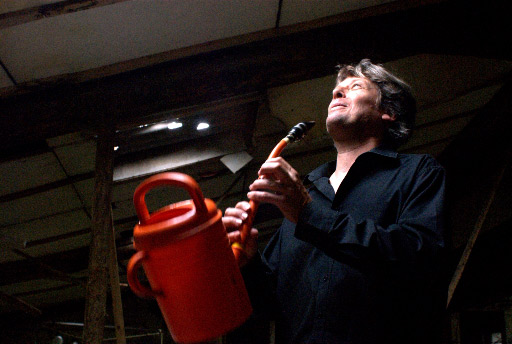 Indeed, the
collaboration between Alain Moreau and Max began long before Tof’s
first show!
Indeed, the
collaboration between Alain Moreau and Max began long before Tof’s
first show!
It was almost thirty years ago. Alain had just finished his actor’s
training and was working on and off in different theatres but was
feeling rather bored. He had forgotten about puppets, about the true
passion he had discovered one day deep in the family attic. He seemed
bent on being an actor....
But then one fine day, during a common project for a street theatre
company, the two of them met, at last!
Max had been hired to make strange musical instruments and Alain to
act several roles, one of them a rabbit on a monocycle in an
adaptation of Alice in Wonderland.
Following this exploit, our two fellow travellers set about creating
their own street show, which turned out to be the unforgettable Duo de
la corde molle.
After two one-time showings of this masterpiece, seeing that his
fellow traveller seemed much more at ease on firm ground with his
hands bursting with puppets than balancing in the air or perched on a
monocycle humming unforgettable songs, Max offered to compose music
for the puppet show Alain and Agnès Lebrun were tinkering around with
in the abandoned workshop where they rehearsed....
And this is how the show Le tour du bloc brought Alain and Max
together in a much more efficient way!
Radio Tom, Camping sauvage, Cabane, Bistouri, Fritkot, Sur la dune and
Premiers pas sur la dune followed, in the same spirit of joy in
collaborating together that continues today.
Collaborating on Piccoli Sentimenti has called for a different
approach to working together. It has been a natural evolution, whereby
the musical component enriches and influences the dramaturgy as much
as the character and the scenography. Max has been very present from
the show’s first experimentations and he has been present at all the
rehearsals. In a perfect osmosis with the world of Antonio Catalano,
Max’s instruments, built in the spirit of what we like to call
Lutherie sauvage (Untamed Lute Making), were right at home!
While the scenography and dramaturgical discoveries of Antonio and
Alain set the show in motion, Max’s musical-visual input completed it
and gave the performance an essential added dimension that soon became
indispensable.
Untamed
lute making
A musical instrument is an object that produces sounds for a
musician to play and express himself. From the primitive “lithophone”
to electronic music, humans have been making music evolve by simply
hitting, rubbing, strumming or blowing into found or invented objects.
Noises and sounds, melodies and rhythms from here and there, stringed
quartets and electric-acoustic music are now part of a huge planetary
vocabulary from which today’s artist is free to draw. 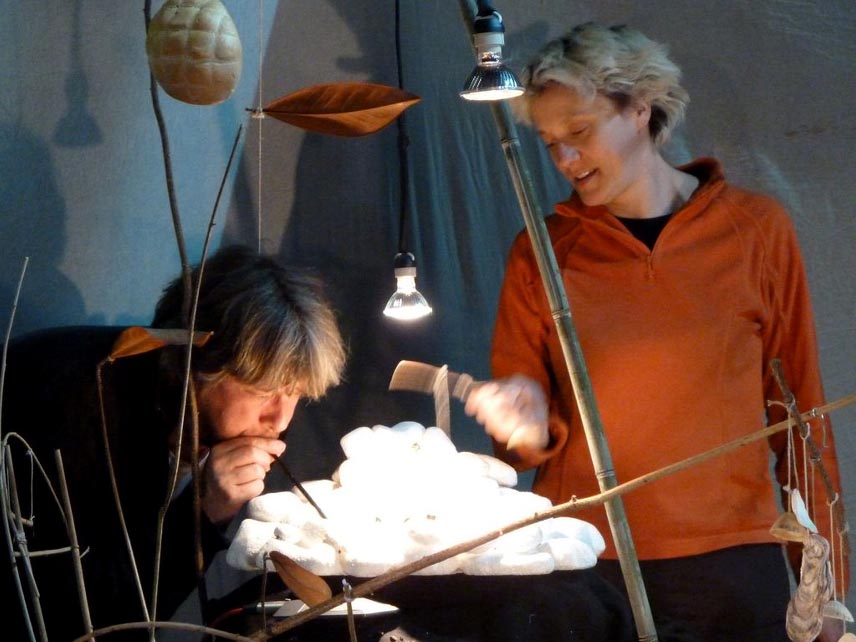 Through
different styles and currents, “untamed lute making” involves creating
musical instruments from objects not specifically designed for this
purpose. It provides us with a permanent terrain of adventure and
discovery, prompting us to continually exceed ourselves. From the
musical clown to the “concrete” but specialized music of Pierre
Schaeffer, the sound sculptures of Tinguely to the steel bands of
Trinidad, generations of researchers and artists have strived to
expand, once and for all, the very notion of the musical instrument.
Through
different styles and currents, “untamed lute making” involves creating
musical instruments from objects not specifically designed for this
purpose. It provides us with a permanent terrain of adventure and
discovery, prompting us to continually exceed ourselves. From the
musical clown to the “concrete” but specialized music of Pierre
Schaeffer, the sound sculptures of Tinguely to the steel bands of
Trinidad, generations of researchers and artists have strived to
expand, once and for all, the very notion of the musical instrument.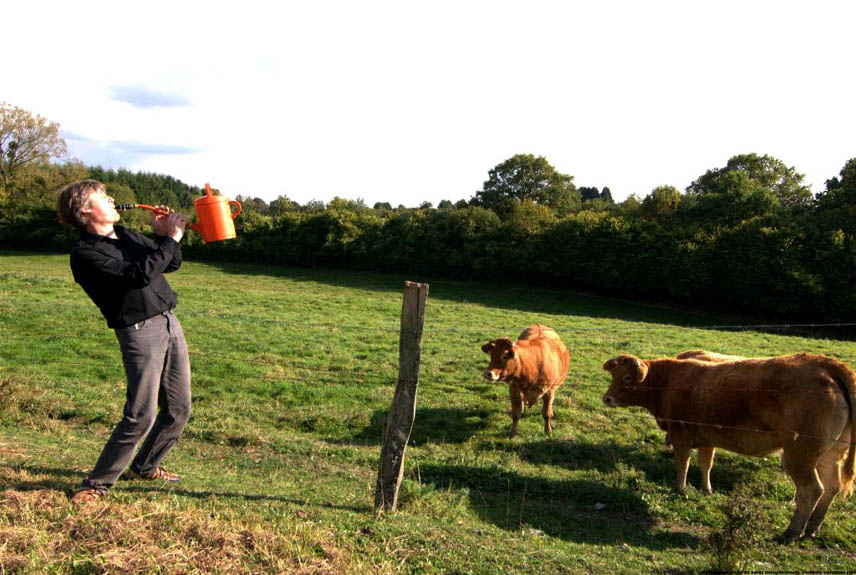 Not only does the use of these instruments enable us to find new,
inimitable, never-heard-of-before sounds, from traditional instruments
to electronic ones, they also introduce new ideas for how to compose
for a kettle or a bicycle, bringing to the musician a completely
different imaginary world from that contained in the symphonic formula
or in the rock orchestra. In this unexplored territory, in so far as
it hasn’t been worked by tradition, the artist has no choice but to
invent. Such an operation, in this sense, involves a profound element
of play and reminds us that, even in its dictionary definition, music
is made to be played. And lastly, “untamed lute making” pushes the
boundaries of the musical domain in order to encounter poetry, theatre
and sculpture.
Not only does the use of these instruments enable us to find new,
inimitable, never-heard-of-before sounds, from traditional instruments
to electronic ones, they also introduce new ideas for how to compose
for a kettle or a bicycle, bringing to the musician a completely
different imaginary world from that contained in the symphonic formula
or in the rock orchestra. In this unexplored territory, in so far as
it hasn’t been worked by tradition, the artist has no choice but to
invent. Such an operation, in this sense, involves a profound element
of play and reminds us that, even in its dictionary definition, music
is made to be played. And lastly, “untamed lute making” pushes the
boundaries of the musical domain in order to encounter poetry, theatre
and sculpture.
Max
Vandervorst
Max Vandervorst is a musician and inventor of instruments.
Since 1988, he has created numerous shows in which his hand-made
instruments have played a major role. His creations adapted from
diverse objects include: Symphonie d’Objets Abandonnés; 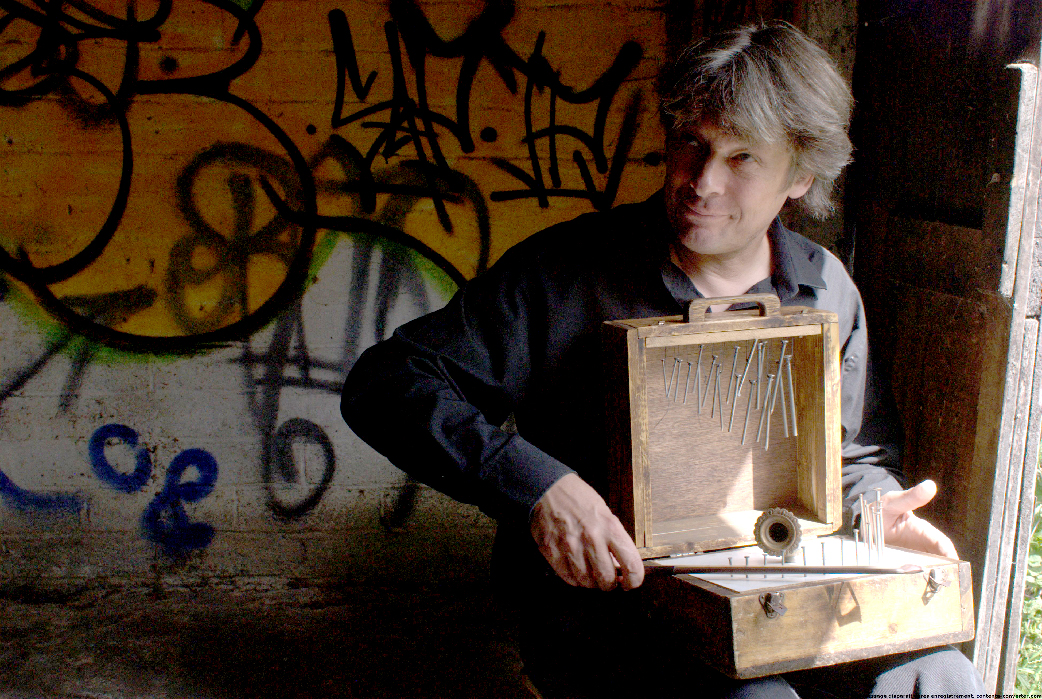 Concerto pour deux vélos, L’Homme de Spa, which continue to be shown
all over the world. He is also a composer of music for the stage and
the founder of the Pataphonie House in Dinant (Belgium) which is a
magical place, entirely devoted to the world of “untamed lute making”
in which anyone can discover or experiment with the strangest
instruments ever imagined.
Concerto pour deux vélos, L’Homme de Spa, which continue to be shown
all over the world. He is also a composer of music for the stage and
the founder of the Pataphonie House in Dinant (Belgium) which is a
magical place, entirely devoted to the world of “untamed lute making”
in which anyone can discover or experiment with the strangest
instruments ever imagined.
Infos : www.maxvandervorst.be

Technical data sheet downloadable by clicking on the wrench